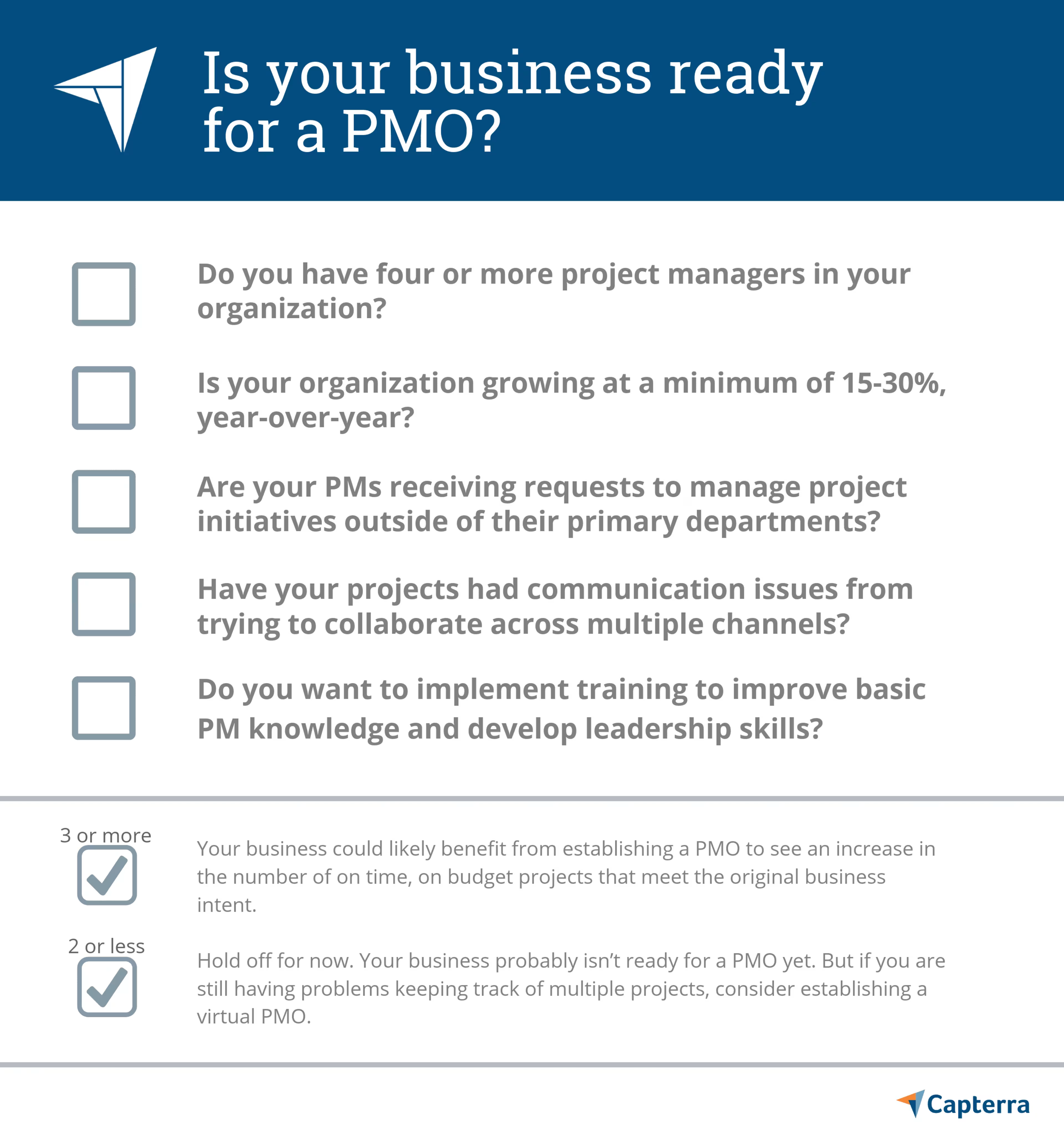Want to save money and increase project success and team productivity? Consider establishing a project management office.

There's an old project management saying that managing a difficult project team is like herding cats.
Of course, experienced project managers know how to use project management software, soft skills, and sound planning to corral those kitties, but what do you do when your organization has grown to the point that your fellow project managers are the ones who need herding?
If your business is working on multiple projects at once, if you have more than just a few project managers, if you have project requests from multiple departments, if your project teams are struggling with communication, and if you're looking to centralize project management training at your organization, your business might be ready to upgrade to a project management office (PMO).
Defining PMO
What is a PMO?
A project management office (PMO) is a group of project managers within an organization that oversees project management across multiple projects throughout that organization.
The simplest way to describe project management offices? Project managers manage projects, while PMOs manage project managers.
PMOs have been around almost as long as project management itself, or at least project portfolio management (the management of an array of projects) has. There has to have been some type of central hub coordinating the many components that went into massive undertakings like the Great Pyramid and the Great Wall of China, even if those hubs weren't explicitly called project management offices.
The Project Management Institute suggests that the first PMO by name was developed by the U.S. Army Air Corps in the 1930s to oversee the development of new aircraft like the Boeing P-26 Peashooter and the Martin B-10 bomber. The U.S. military PMO evolved as development increased on more complex programs such as long-range missile systems and spacecraft.
According to a PMI presentation on the evolution of the PMO:
"They oversaw not only entire project systems (e.g., the missile), but also its warhead, support equipment, launcher, and training and logistics support. The key benefits of this project office were to centralize funding into work packages instead of separate components, improve budget predictions, facilitate a standard phased planning approach, and identify non-strategic initiatives before fund allocation."
By the 1980s, the rapid expansion of computer technology and business software allowed for the widespread adoption of PMOs in the private sector. Since then, project management offices have been a staple of any large scale operation with multiple ongoing projects across departments.
"Organizations started to search for more efficient ways to manage their increased number of projects and resulting compromised performance (e.g., delays, cost overruns, and falling short of quality and specifications), and to question if their projects should be run in isolation, or managed in a coordinated way to improve resource utilization and to avoid cross-projects' conflicts."
PMOs might use documentation such as the Project Management Body of Knowledge (PMBOK) to maintain standards and serve as reference material to handle unprecedented issues.
What each PMO actually looks like in terms of structure and makeup varies from organization to organization depending on size and complexity, but every PMO should have a similar goal: to organize and facilitate project management throughout an organization.
Why do I need a PMO, and how will a PMO benefit me?
Like a helipad or public stock offering, project management offices may be one of those things that seems to be reserved only for large corporations. But they're not.
The 2016 State of the Project Management Office (PMO) report by PM Solutions research found that 85% of organizations (small, midsize, and large) already have a project management office in place. And while large firms (more than $1 billion in annual revenue) inflate that statistic with almost 95% in the PMO camp, a significant majority of small (less than $100 million) and midsize ($100 million to $1 billion) firms also have PMOs, at 75% and 83%, respectively.

Keep in mind that the PM Solutions definition of a small business cuts a wide swath. A 100-employee construction firm making $90 million per year almost certainly needs a PMO, while a five-employee coffee shop making $100,000 per year almost certainly does not.
So, rather than focus on whether or not your business should or shouldn't have a PMO, let's look at how a PMO can benefit your SMB, so that you can decide for yourself.
Gartner analyst Michael Hanford (Full article available to Gartner clients) writes that a PMO can benefit your business by facilitating:
Faster, better, more optimal decision-making, and the ability to ensure that you're working on the highest-value opportunities at all times
Increased project throughput (getting more done with the same money, time, and resources)
A more flexible and agile organization that can better address changing business needs
Reduced costs and schedule risk on projects
The statistics bear out these findings. PM Solutions Research found that organizations with PMOs outperform those that don't in the following ways:
33% more projects delivered under budget
27% improvement in customer satisfaction
25% improvement in productivity
43% improvement in alignment of projects with firm's objectives
25% decrease in failed projects
$175,000 cost savings per project
Establishing a PMO is a proven way to save money and increase project success and team productivity. So why shouldn't every team establish a PMO? Let's take a look.
3. What are the signs that it's time for a PMO?
If you have a small team working on one or two projects at a time and you haven't had any issues with communication or resource allocation, you're most likely fine without a PMO.
But as soon as your team grows to a point where you have more than just a few project managers working on multiple, simultaneous projects across departments, a PMO can help your teams communicate better, share knowledge and resources, and coordinate projects to maximize efficiency.
In her article, "Does Your SMB Need A Project Management Office?" Capterra's Senior Project Management Analyst Eileen O'Loughlin identifies four key indicators that business leaders should monitor to determine if they're ready to establish a PMO:
Number of project managers
Number and complexity of projects within portfolio
Expected growth (for the team and/or organization)
Project requests coming from multiple departments
Though there is no one-size-fits-all threshold to follow for exactly when you need to establish a PMO, keeping an eye on these indicators along with your team's ability to successfully deliver projects can give you a good idea of whether you should establish a PMO or not.
2 Example Organizations That Could Benefit From a PMO
Organization A has three project managers, two simultaneous projects of medium complexity, with project requests coming from two different departments, and expected growth of 10% year over year. At the same time, the company is struggling with communication, resource allocation, and project success.
Organization B has five project managers working on three complex projects coming from three different departments with expected growth of 25% year over year and is handling everything successfully.
While Organization A has a smaller project management team and less complex portfolio, it is in dire need of a PMO because it is struggling in areas that a PMO can help with.
That isn't to say that Organization B couldn't benefit from a PMO. While it might just be filling the gaps with project experience and technology, it'd be wise to establish a PMO before further growth begins to reveal its limitations.
A good rule of thumb, according to O'Loughlin, is that if you have four or more project managers, if you're growing by more than 15% year over year, if you're receiving project requests from multiple departments, if you're having communication issues, and if you're looking to implement project management training across your organization, you're ready for a PMO.

Not ready for a full PMO? Consider a virtual PMO
It might be daunting to think about launching a project management office from scratch: Where will they sit? How much more coffee will they drink? Do they need their own T-shirts? But it's less daunting if you approach your first PMO as more of a gathering of resources and opening of communication channels.
Say you have five project managers struggling to coordinate on various projects across departments, and maybe even across sites. A good start is to launch a dedicated channel on your collaboration tool and designate a senior project manager as your PMO leader to lead your virtual PMO, help coordinate cross-department projects, facilitate communication, and share resources.